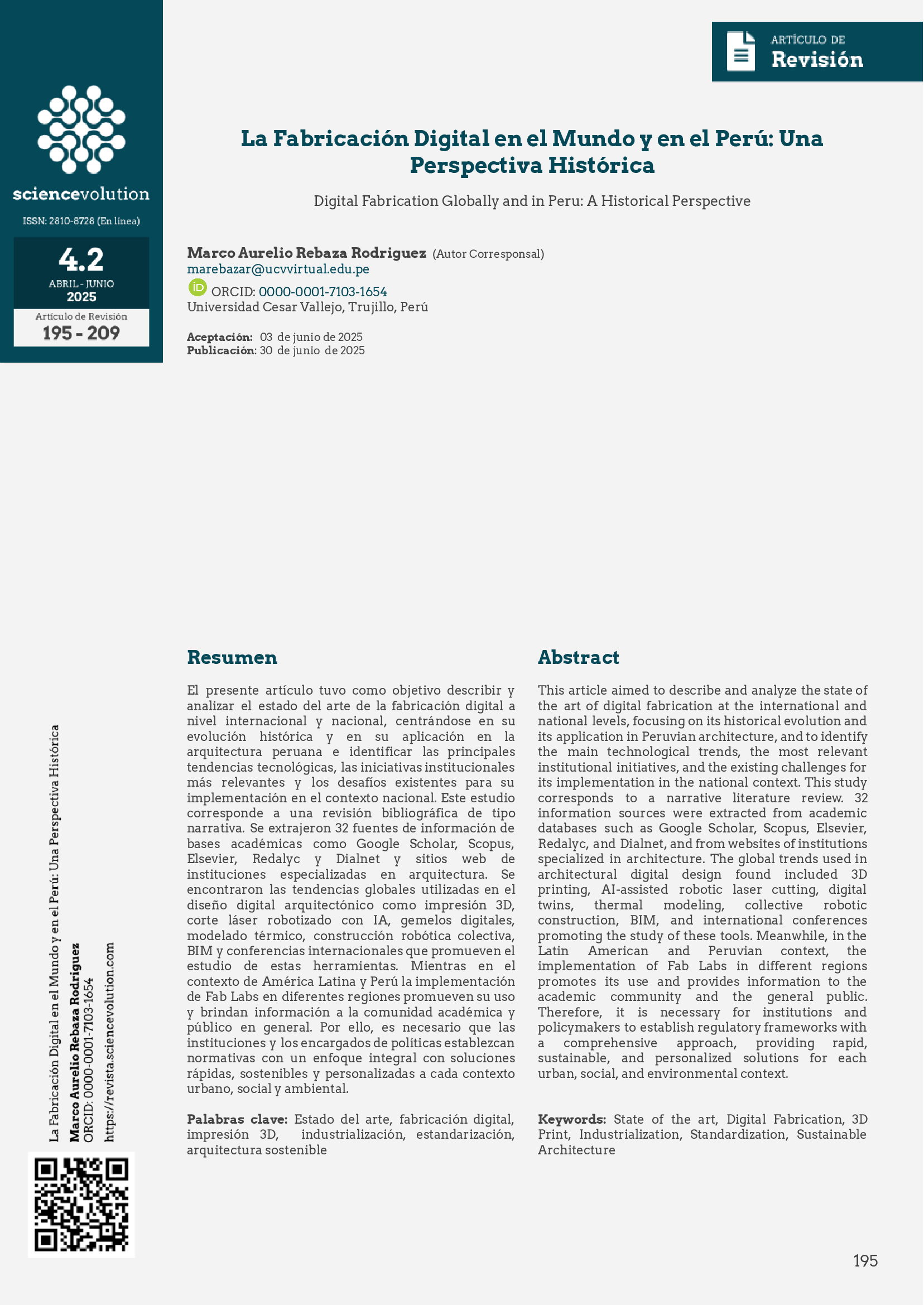Abstract
This article aimed to describe and analyze the state of the art of digital fabrication at the international and national levels, focusing on its historical evolution and its application in Peruvian architecture, and to identify the main technological trends, the most relevant institutional initiatives, and the existing challenges for its implementation in the national context. This study corresponds to a narrative literature review. 32 information sources were extracted from academic databases such as Google Scholar, Scopus, Elsevier, Redalyc, and Dialnet, and from websites of institutions specialized in architecture. The global trends used in architectural digital design found included 3D printing, AI-assisted robotic laser cutting, digital twins, thermal modeling, collective robotic construction, BIM, and international conferences promoting the study of these tools. Meanwhile, in the Latin American and Peruvian context, the implementation of Fab Labs in different regions promotes its use and provides information to the academic community and the general public. Therefore, it is necessary for institutions and policymakers to establish regulatory frameworks with a comprehensive approach, providing rapid, sustainable, and personalized solutions for each urban, social, and environmental context.
References
Arab Society for Computation in Architecture, Art and Design. (2025). Decolonizing Architecture: AI, Computation, and the Future of Localized Design. AS. https://www.ascaad.org/conference/2025/
Berdillana Rivera, A., & Chirinos Sota, J. (2013). Tecnologías de visualización de la información y su uso en la gestión de proyectos. Diseño y construcción. ICA: Revista de Investigación en Ciencia y Arquitectura, 6(1), 57-68. https://revistas.uni.edu.pe/index.php/ica/article/view/1765
College of Architecture and Urban Planning, Tongji University. (2024). CDRF 2025 Abstract Submission. The 7th International Conference on Computational Design and Robotic Fabrication – Conference theme: Transindividual intelligence. Springer. https://caup.tongji.edu.cn/caupen/40/0a/c33444a344074/page.htm
Fab Lab Esan, Centro de Innovación Tecnológica. (s.f.). Diploma en especialización en fabricación digital e innovación. Recuperado el 29 de mayo de 2025, de. https://fablab.esan.edu.pe/aprende-con-nosotros/diplomados/especializacion-en-fabricacion-digital-e-innovacion/
Fernández Arribasplata, M. (2020). Laboratorios de fabricación digital ofrecen tecnología solidaria en tiempos de COVID‑19. Agencia Andina. https://andina.pe/agencia/noticia-laboratorios-fabricacion-digital-ofrecen-tecnologia-solidaria-tiempos-covid19-813782.aspx
Gobierno del Perú. (2024a). Fab Lab Perú. https://www.gob.pe/28171-fab-lab-peru
Gobierno del Perú. (2024b). Laboratorios de la Academia de la Red Nacional de Laboratorios de Innovación Digital. https://www.gob.pe/28102-laboratorios-de-la-academia-de-la-red-nacional-de-laboratorios-de-innovacion-digital
González-Hernández, I. J., Armas-Alvarez, B., Coronel-Lazcano, M., Maldonado-López, N., Vergara-Martínez, O., & Granillo-Macías, R. (2021). El desarrollo tecnológico en las revoluciones industriales. Ingenio Y Conciencia Boletín Científico De La Escuela Superior Ciudad Sahagún, 8(16), 41–52. https://doi.org/10.29057/escs.v8i16.7118
Gyasi, E. A., Antila, A., Owusu-Ansah, P., Kah, P., & Salminen, A. (2022). Prospects of robot laser cutting in the era of industry 4.0. World Journal of Engineering and Technology, 10(03), 639–655. https://doi.org/10.4236/wjet.2022.103042
ICD/ITKE University of Stuttgart. (2019). BUGA Wood Pavilion 2019 [Fotografía]. https://www.icd.uni-stuttgart.de/projects/buga-wood-pavilion-2019/
Ivanov-Kostetskyi, S., Gumennyk, I., & Voronkova, I. (2021). Innovative trends in architecture – Creating full-scape buildings with the 3D print technology. IOP Conference Series: Materials Science and Engineering, 1203(2), 022099. https://doi.org/10.1088/1757-899X/1203/2/022099
Khudhair, A., Li, H., Ren, G., & Liu, S. (2021). Towards Future BIM Technology Innovations: A Bibliometric Analysis of the literature. Applied Sciences, 11(3), 1232. https://doi.org/10.3390/app11031232
Leder, S., & Menges, A. (2023). Architectural design in collective robotic construction. Automation in Construction, 156, 105082. https://doi.org/10.1016/j.autcon.2023.105082
Leder, S., & Weber, R. (2018). Distributed robotic assembly system for in-situ timber construction [Fotografía]. ICD/ITKE, University of Stuttgart. https://www.icd.uni-stuttgart.de/teaching/master-theses/itech-m-sc-2018-distributed-robotic-assembly-system-for-in-situ-timber-construction/
Llanes-Font, M., & Lorenzo-Llanes, E. (2021). La cuarta revolución industrial y una nueva aliada: calidad 4.0. Centro de Información y Gestión Tecnológica de Holguín, 27(2). 67-78 . https://www.redalyc.org/journal/1815/181566671006/html/
Madić, M., Petrović, G., Petković, D., Antucheviciene, J., & Marinković, D. (2022). Application of a robust Decision-Making rule for comprehensive assessment of laser cutting conditions and performance. Machines, 10(2), 153. https://doi.org/10.3390/machines10020153
Marin Mamani, G. (2022). Integración de la inteligencia artificial en la arquitectura en América Latina: Desafíos y oportunidades. Revista de Arquitectura y Urbanismo Taypi, 1(2), 10–11. https://revistas.unap.edu.pe/taypi/index.php/taypi/article/view/679
Martínez-Manso, H., & Delgado-Fernández, T. (2022). Arquitectura básica de diseño de gemelos digitales para la construcción. Revista de Investigación, Desarrollo e Innovación, 12(2), 327–336. https://doi.org/10.19053/20278306.v12.n2.2022.15275
Ministerio de Economía y Finanzas. (2024). Decreto Supremo N.° 203‑2024‑EF. Normas Legales, Diario Oficial El Peruano. https://epdoc2.elperuano.pe/EpPo/VistaNLSE.asp?Referencias=MjMzNzkwOC0xMjAyNDEwMjY=
Pontificia Universidad Católica del Perú. (s.f.). Diplomatura de estudio en Fabricación Digital para el Sector Industrial. Recuperado el 27 de mayo de 2025, de . https://www.pucp.edu.pe/diplomatura/fabricacion-digital-sector-industrial/
Revista Costos. (2021). Avance de la adopción del BIM en el Perú: un panorama pospandemia. https://revista-ps.costosperu.com/avance-de-la-adopcion-del-bim-en-el-peru-un-panorama-pospandemia/
RILEM & Southeast University. (2025). 5th RILEM International Conference on Concrete and Digital Fabrication & 6th International Conference on 3D Printing Concrete Materials and Structures (DC2026 & 3DPCMS‑2026). https://www.digitalconcrete2026.com/
Tan Tan, Ng, M. S., & Hall, D. M. (2023). Demystifying barriers to digital fabrication in architecture. En 2023 Engineering Project Organization Conference, Berlín, Alemania. https://www.researchgate.net/publication/371044563_Demystifying_Barriers_to_Digital_Fabrication_in_Architecture
Taylor-Foster, J. (2016). Expanded audiences and the “second building” – An interview with CCA Director Mirko Zardini. ArchDaily. https://www.archdaily.com/788868/expanded-audiences-and-the-second-building-nil-an-interview-with-cca-director-mirko-zardini
Tian, F. (2018). Elytra Filament Pavilion, WAIC West Bund Shanghai [Fotografía]. Institute for Computational Design and Construction, Universität Stuttgart. https://www.icd.uni-stuttgart.de/projects/elytra-filament-pavilion-at-world-ai-conference-shanghai/
Tovar, E. (2023). Fabricación digital y biomateriales en la arquitectura: Fusionando identidad y tecnología [Digital fabrication and biomaterials in architecture: Fusing identity and technology] (A. Iñiguez, Trad.). ArchDaily Perú. https://www.archdaily.pe/pe/1005150/fabricacion-digital-y-biomateriales-en-la-arquitectura-fusionando-identidad-y-tecnologia
Travez Tipan, A. V., & Villafuerte, C. (2023). Industria 5.0, revisión del pasado y futuro de la producción y la industria. Ciencia Latina Revista Científica Multidisciplinar, 7(1), 1059–1070. https://doi.org/10.37811/cl_rcm.v7i1.4457
Trialta Perú. (2025). Tendencias arquitectónicas 2025: Innovación sostenible y digital desde la perspectiva técnica de Trialta (Perú). Trialta. https://trialta.pe/tendencias-arquitectonicas-2025-innovacion-sostenible-y-digital-desde-la-perspectiva-tecnica-de-trialta-peru/
van d’Grachten, C. (2023). BUGA Wood Pavilion – Reuse 2023. [Fotografía]. Institute for Computational Design and Construction, University of Stuttgart. https://www.icd.uni-stuttgart.de/projects/buga-wood-pavilion-reuse-2023/
Xu, X., Lu, Y., Vogel-Heuser, B., & Wang, L. (2021). Industry 4.0 and Industry 5.0—Inception, conception and perception. Journal of Manufacturing Systems, 61, 530–535. https://doi.org/10.1016/j.jmsy.2021.10.006
Yu, B. (2017). ICD Sewn Timber Shell 2017 [Fotografía]. Institute for Computational Design and Construction, University of Stuttgart. https://www.icd.uni-stuttgart.de/projects/icd-sewn-timber-shell-2017/

This work is licensed under a Creative Commons Attribution-NonCommercial-NoDerivatives 4.0 International License.

